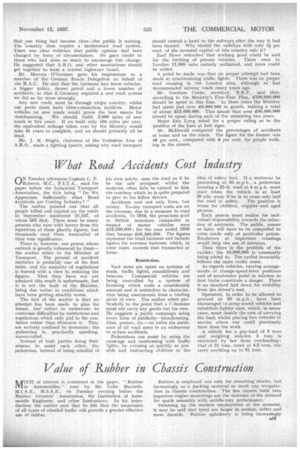What Road Accidents Cost industg
Page 21

If you've noticed an error in this article please click here to report it so we can fix it.
QN Tuesday afternoon Captain C. F. Roberts, MC., F .I.T. A . , read his paper before the Industrial Transport -Association, the title being " Do We Appreciate Sufficiently what Road Accidents are Costing Industry? "
The author pointed out that all people killed and injured on the roads in September numbered 21,517, of whom 583 died. There must he many persons who turn with horror from the repetition of these ghastly figures, but thousands read them unmindful of their true significance.
There -is, however, one person whose outlook is greatly influenced by them— the author refers to the Minister of Transport. The perusal of accident statistics is probably one of his first tasks, and the majority of regulations is framed with a view to reducing the figures. That they have not yet attained this result is unfortunate, but it is not the fault of the Minister, being due rather to conditions which have been getting steadily worse.
The fact of the matter is that no attempt has been made to plan for future, but' rather to endeavour to overcome difficulties by restrictions and regulations which only add to the confusion rather than eliminate it, They are entirely confined to motorists; the pedestrian is, practically speaking, uncontrolled.
Instead of both parties doing their .utmost to assist each other, the pedestrian, instead of being mindful of his own safety, uses the road as if he he the sole occupant, whilst the motorist often fails to extend to him the courtesy which he is quite prepared to give to his fellow drivers.
Accidents cost not only lives, but money. To-day transport costs are on the increase, due in a measure to road accidents. In 1934, the premiums paid to British insurance companies in respect of motor vehicles were £31,500,000; for the year ended 1936 they became £35,200,000. The figures represent the total business and include figures for overseas business, which, in some cases, exceeds that transacted at borne.
Restriction.
Vast sums are spent on systems of studs, traffic lights, roundabouts and beacons. Commercial vehicles are being controlled by a system of licensing which costs a considerable amount and is restrictive in character, thus being uneconomic from a trading point of view. The author refers particularly to the point that a C-licensee must not carry any goods but his own. He suggests a public campaign using every form of publicity—broadcasting, films, posters, etc.—to enlist the assistance of all road users in an endeavour to reduce accidents.
Pedestrians can assist by using the crossings and conforming with traffic lights, by crossing as quickly as possible and instructing children in the idea of safety first. If. a motorcar be proceeding at 30 m.p.h., a pedestrian crossing a 25-ft. road at 4 m.p.h. must start when the vehicle is at least 30 yds. away if he is to cross only half the road in safety. The position is worse for children, cripples and aged persons.
Each person must realize his individual responsibility towards the reduction of accidents. The public, sooner or later, will have to be compelled to cross roads only at particular points. Escalators at important crossings would help the use of subways.
Then there is the problem of the cyclist; the 10,000,000 is constantly being added to. The cyclist invariably follows the main traffic route, As regards vehicles, varying arrangements of change-speed-lever positions and of accelerator pedal in relation to foot brake constitute a danger. There is no standard laid down for visibility from the driver's seat.
Operators, in order to be allowed to proceed at 30 m.p.h., have been encouraged to scrap sound vehicles and substitute lighter ones, which, in many cases, must double the cost of carrying the load, whilst placing two vehicles: in service where one could previously have done the work.
A vehicle for a pay-load of 8 tons and weighing unladen 4 tons is restricted by law from overloading ; that of 21 tons, rated at 4-5 tons, can carry anything up to 91 tons. "








































